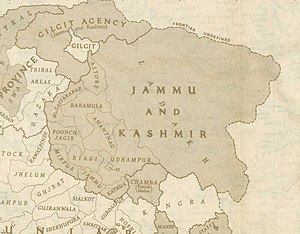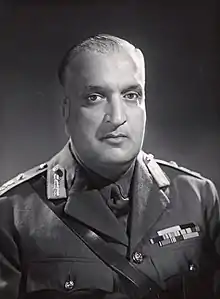1947–1948 Rajouri massacre
The 1947–1948 Rajouri Massacres were the targeted killing of thousands of Hindu and Sikh residents and refugees in the Rajouri tehsil in the princely state of Jammu and Kashmir, by the Azad Kashmir Forces and Pashtun tribal militia during the First Kashmir War.[3][4] The 'siege' of the town of Rajouri began on 7 November 1947 and ended on the 12 April 1948 when the Indian Army recaptured it. The massacre is commemorated annually in Rajouri and the Union Territory of Jammu and Kashmir.[4][5]
| 1947–1948 Rajouri massacre | |
|---|---|
| Date | 7 November 1947–12 April 1948 |
| Location | 33°23′N 74°19′E |
| Goals | Retributive genocide[1] |
| Methods | Rioting, pogrom, arson, enslavement, forced conversions, looting[2] |
| Casualties | |
| Death(s) | 30,000+ Hindus/Sikhs |
 Rajouri Location within Jammu and Kashmir | |
Background
At the time of the Partition of India in 1947, princely states were left with the options of joining India or Pakistan or remaining independent. Hari Singh, the Maharaja of Jammu and Kashmir, preferred to remain independent. All major political groups of the state supported the Maharaja's decision, except for the Muslim Conference, which declared in favour of accession to Pakistan on 19 July 1947.[6] The Muslim Conference was popular in the Jammu province of the state. It was closely allied with the All-India Muslim League, which was set to inherit Pakistan.
Between September and November 1947, Rajouri and Poonch witnessed a mass influx of Hindu and Sikh refugees from the west trying to escape the raiders. Rajouri's population swelled from 5,000 to over 40,000. Poonch experienced an increase from 10,000 to almost 50,000 people.[7]
Events

In late October 1947, thousands of tribal raiders from Pakistan entered Kashmir overrunning outposts of Hari Singh’s state forces in Muzaffarabad, Domel and other places.[8] On the night of October 26-27, the tribal raiders attacked Baramulla during which thousands of Hindu men, women and children were killed.[8][9] This caused the Maharaja to accede to India and India to airlift troops to defend the Kashmir Valley.
Around 7th November 1947, the Pakistani tribal raiders, along with the rebels and deserters from the western districts of the princely state, began the effort to capture Rajauri. On 12 November 1947, there were coordinated killings of young Hindu and Sikh males ordered by Sakhi Diler and Colonel Rehmat Ullah Khan, despite objections from detained local leaders. Sources state 3,000 to 7,000 people were killed on that day.[10] The town of Rajouri was surrounded by Muslim mobs who carried out extensive killings, loot and rapes of Hindu and Sikh residents. 30,000 Hindus and Sikhs living in Rajauri were reportedly killed, wounded or abducted.[11][12][13] Many women committed suicide to avoid being raped or tortured.[4] There was a mass displacement of people to areas such as Mirpur, Jammu etc. There are also recorded instances of a few individuals who converted to Islam in order to avoid the atrocities.[14]
Rajauri was recaptured on 12 April 1948 by the 19 Infantry Brigade of the Indian Army under the command of Second Lieutenant Rama Raghoba Rane. Rane, despite being wounded, launched a bold tank assault by conveying the tanks over the Tawi river bed in order to avoid the road blocks along the main road.[15] When the Indian Army entered the town, the captors had fled, having destroyed most of the town and killing all its inhabitants.
Aftermath
After recapturing Rajouri and the arrival of the Indian Army, some 1,500 refugees that had fled to the hills, including women and children, returned to the town.[16] The capture of Rajouri and the Rajouri Massacre was followed by the capture of Mirpur by Pakistani backed tribals and the subsequent Mirpur Massacre of Hindus and Sikhs.
The ceasefire line at the end of the war ran to the west of Rajouri district.
April 13 every year is now celebrated as Vijay Diwas in Rajouri.[17] The headquarters of the 25 Infantry Division in Rajouri has a sign in commemoration of the massacre.[18]
See also
References
- Bhatia, Rethinking Conflict at the Margins (2020), p. 82: Quoting Amar Nath Saraf: "I remember hearing on Pakistan radio that these killings [in Jammu] would be avenged — in Mirpur, Rajouri, Kotli, Mendhar....
- Bloeria, Sudhir (15 October 2020). "Militancy in Rajouri and Poonch". satp.org. South Asian Terrorism Portal. Retrieved 15 October 2020.
- Bhatia, Rethinking Conflict at the Margins (2020), pp. 80–81: "During this time, the town of Rajouri was captured by what was known as 'Azad Kashmir forces' (comprised of armed rebels from Poonch and a section of Pakistani officials sympathetic to these rebels) as well as the Pathan tribesmen."
- Tearful homage to martyrs of 1947 massacre in Rajouri, Daily Excelsior, 12 November 2017.
- Maini, K.D. (12 April 2015). "The day Rajouri was recaptured". dailyexcelsior.com. Daily Excelsior. Retrieved 19 October 2020.
- Puri, Balraj (November 2010), "The Question of Accession", Epilogue, 4 (11): 4–6,
Eventually they agreed on a modified resolution which 'respectfully and fervently appealed to the Maharaja Bahadur to declare internal autonomy of the State... and accede to the Dominion of Pakistan... However, the General Council did not challenge the maharaja's right to take a decision on accession, and it acknowledged that his rights should be protected even after acceding to Pakistan.
- Bloeria, Sudhir (15 October 2020). "Militancy in Rajouri and Poonch". satp.org. South Asian Terrorism Portal. Retrieved 15 October 2020.
- "Recalling a Pakistan misadventure: What happened on October 22, 1947". indianexpress.com. indianexpress.com. 20 October 2020. Retrieved 20 October 2020.
- "India observes 22 October as Black Day to mark 1947 invasion of J&K by Pakistani raiders; two-day symposium to feature photos, videos from siege". firstpost.com. firstpost.com. 20 October 2020. Retrieved 20 October 2020.
- Maini, K.D. (12 April 2015). "The day Rajouri was recaptured". dailyexcelsior.com. Daily Excelsior. Retrieved 19 October 2020.
- Prasad, Sri Nandan; Pal, Dharm (1 January 1987). Operations in Jammu & Kashmir, 1947–48. History Division, Ministry of Defence, Government of India. pp. 49–50.
- Singh, Leadership in the Indian Army 2005, p. 160.
- Ramachandran, Empire's First Soldiers 2008, p. 171.
- Farooq, Omer (25 June 2018). "Divided by War, reunited by Web: The Partition saga of two Rajouri sisters". Free Press Kashmir.
- Rama Raghoba Rane received a Param Vir Chakra for his gallantry.
- Sarkar, Outstanding Victories of the Indian Army 2016, pp. 37–40.
- Maini, K.D. (12 April 2015). "The day Rajouri was recaptured". dailyexcelsior.com. Daily Excelsior. Retrieved 19 October 2020.
- https://www.dailyo.in/politics/pakistan-indian-army-azad-jammu-kashmir-rajouri-massacre-1947-china-pok/story/1/13643.html
Bibliography
- Bhatia, Mohita (2020), Rethinking Conflict at the Margins: Dalits and Borderland Hindus in Jammu and Kashmir: Going Beyond the Dominant Discourse, Cambridge University Press, ISBN 978-1-108-83602-9
- Chattha, Ilyas Ahmad (September 2009). Partition and Its Aftermath: Violence, Migration and the Role of Refugees in the Socio-Economic Development of Gujranwala and Sialkot Cities, 1947-1961 (PhD). Centre for Imperial and Post-Colonial Studies, School of Humanities, University of Southampton. Retrieved 16 February 2016.
- Chattha, Ilyas (2016). "The Long Shadow of 1947: Partition, Violence and Displacement in Jammu & Kashmir". In Amritjit Singh; Nalini Iyer; Rahul K. Gairola (eds.). Revisiting India's Partition: New Essays on Memory, Culture, and Politics. Lexington Books. pp. 143–156. ISBN 978-1-4985-3105-4.
- Copland, Ian (1991). "The Abdullah Factor: Kashmiri Muslims and the Crisis of 1947". In D. A. Low (ed.). Political Inheritance of Pakistan. Springer. ISBN 9781349115563.
- Das Gupta, Jyoti Bhusan (2012) [first published 1968]. Jammu and Kashmir. Springer. ISBN 978-94-011-9231-6.
- Singh, V. K. (23 March 2005). Leadership in the Indian Army: Biographies of Twelve Soldiers. SAGE Publications. p. 160. ISBN 9780761933229.
- Ramachandran, D. P. (2008). Empire's First Soldiers. Lancer Publishers. p. 171. ISBN 9780979617478.
- Sarkar, Col. Bhaskar (2016). Outstanding Victories of the Indian Army, 1947-1971. Lancer Publishers. pp. 40–. ISBN 978-1-897829-73-8.
- Snedden, Christopher (2013) [first published as The Untold Story of the People of Azad Kashmir, 2012]. Kashmir: The Unwritten History. HarperCollins India. ISBN 978-9350298985.

